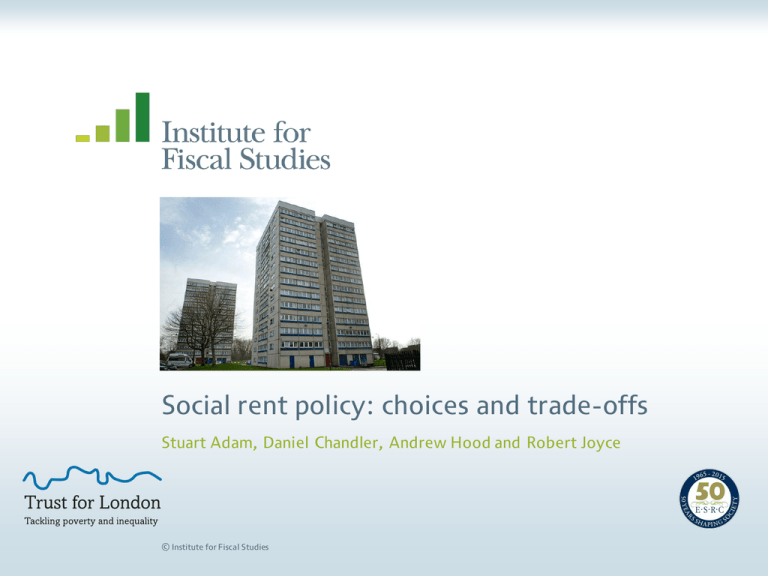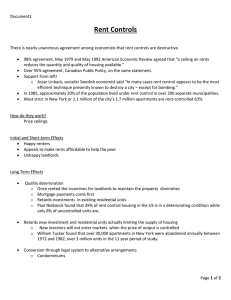Social rent policy: choices and trade-offs © Institute for Fiscal Studies
advertisement

Social rent policy: choices and trade-offs Stuart Adam, Daniel Chandler, Andrew Hood and Robert Joyce © Institute for Fiscal Studies Policy background and trade-offs Robert Joyce © Institute for Fiscal Studies % of population living in social housing (GB) 40% Local authority Housing association 35% 30% 25% 20% 15% 10% 5% Source: Figure 2.1 of Social rent policy: choices and trade-offs © Institute for Fiscal Studies 2013 2011 2009 2007 2005 2003 2001 1999 1997 1995 1993 1991 1989 1987 1985 1983 1981 1979 1977 1975 1973 1971 1969 0% Social tenants are a relatively poor group % of GB average 100% Median weekly earnings Employment rate Median household income 90% 80% 70% 60% 50% 40% Source: Figure 2.2 of Social rent policy: choices and trade-offs © Institute for Fiscal Studies 2013 2011 2009 2007 2005 2003 2001 1999 1997 1995 1993 1991 1989 1987 1985 1983 1981 1979 30% Who lives in social housing? Social renters Whole population Under 16 24.3% 18.4% 16–64 59.9% 64.4% 65 plus 15.8% 17.1% 8.2% 29.0% 17.6% 6.1% Age Graduate (aged 25–64) Receiving disability benefits (aged 16–64) Source: Table 2.1 of Social rent policy: choices and trade-offs © Institute for Fiscal Studies We focus on choice over level of rent they pay • Social housing providers combine at least three functions: – Construction – Landlords – Sub-market rents • We focus only on rents – Taking rest of social housing system as given – But rent changes can have knock-on effects on (e.g.) construction, which we discuss • Analyse effects of big changes to social rent policy in England – ‘Affordable Rents’ (i.e. higher rents) for new tenancies – 1% annual cuts in social rents for next four years – ‘Pay to Stay’: market or near market rents for higher-income tenants © Institute for Fiscal Studies Rents in social housing • Tightly constrained by central regulations • Since early 2000s, each social property has a ‘formula rent’ – Depends on capital value, local earnings levels and property size – Has increased in real terms each year – Properties below formula rent had to gradually move towards it – Central aim was to achieve ‘convergence’ between council and HA rents – process now largely complete • Now, centrally-imposed constraints on most rents are: – Cannot be more than 5% above formula rent – Maximum annual rent increases for a given property © Institute for Fiscal Studies Mean weekly rents, 2015 Private rented sector Social rented sector Estimated market rent on social properties Estimated social rent subsidy Estimated social rent subsidy (% of market rent) England £172 £96 £136 £40 29% North East £118 £81 £99 £18 18% London £267 £123 £191 £68 36% South East £177 £107 £166 £59 36% Source: Table 2.2 of Social rent policy: choices and trade-offs © Institute for Fiscal Studies Social rent subsidies: how are they financed? • Social landlords are not-for-profit • Can cover their costs at below-market rents because: – Construction was subsidised by central govt (so lower debt) – Much of stock old enough that debt paid off – Market rents have risen faster than landlords’ costs • So despite many years of real increases in social rents, gap between social and market rents remains substantial © Institute for Fiscal Studies Housing benefit (HB) for social tenants • 2/3 of social tenants receive further rent subsidy in form of HB • HB entitlement is means-tested against current income and assets • For poorest, it typically covers all rent. Exceptions: – Those affected by social sector size criteria (‘bedroom tax’): covers 75% or 86% of rent – Those affected by benefit cap • HB will rise to fully cover a rent increase – Or fall to offset the gain to a tenant from a rent reduction – Only exceptions are those affected by benefit cap or ‘bedroom tax’ © Institute for Fiscal Studies Raising social rent levels: impacts on households • If not on HB, makes social tenants worse off • If on HB, most tenants no worse off – HB rises to cover rent rise • Work incentives typically weakened: more reliance on HB, eligibility for which depends on having low income • Higher rents also make being in social housing less attractive • – Weakens incentive to gain access to social housing in first place – Weakens incentive for existing tenants to stay in sector (e.g. rather than move for job opportunity or take up Right to Buy) These incentive effects could (though will not necessarily) affect people’s choices over work and housing tenure © Institute for Fiscal Studies Raising social rent levels: impacts on central government and housing providers • Higher rents mean higher HB spending by central government... • ...but more income for social landlords • – As not-for-profits, that should get re-invested in housing – New construction, extra maintenance or management services, etc These indirect effects likely to offset some of overnight impacts – © Institute for Fiscal Studies e.g. more construction social housing extended to more people more people get subsidised rents





